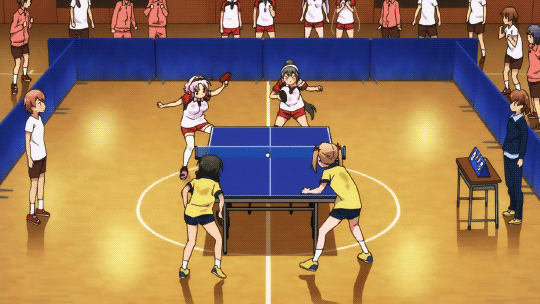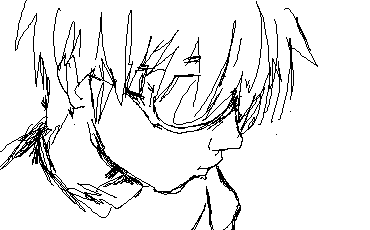
For a solid recent example of sakuga, Trigger’s Little Witch Academia (now a TV anime!) short is truly exceptional.
Since the days of Astro Boy, the Japanese animation industry has by and large followed a conservative production model, relying on cost-saving limited animation tricks. Sometimes, however, a scene sticks out. A punch feels more powerful than usual. An explosion billows across the screen, emitting trails of smoke. A character subtly shifts his or her weight, betraying anxiety. In these moments, we notice the animation itself—the art of creating motion through drawings, distinct from other disciplines like background art or character design. In the past decade, a group of anime fans have coalesced around an appreciation for animation as an art form. They call themselves “sakuga fans.”
Sakuga is simply the Japanese word for animation (the craft, unlike anime, that refers to the works themselves). Like many loanwords, however, it has taken on a special meaning in the English-speaking world, where fans use it to label scenes with particularly interesting motion or effects. At the risk of grossly oversimplifying things, you could say sakuga refers to the scenes where the “animation quality is higher.” Often they feature a higher number of drawings per second or more exaggerated poses than the rest of the animation in an episode.
Humble Beginnings
Blogger Ben Ettinger is very familiar with sakuga fandom. After all, in many ways he started it.
In the late 90s, fresh out of college with a degree in Japanese and Asian studies, Ben pored over Roman Albums and issues of Animage, searching for interviews and other insights into the minds of his favorite anime directors and writers. Through online Japanese communities like 2ch, he discovered animators like Norio Matsumoto (Naruto), Masaaki Yuasa (Ping Pong), and Takeshi Koike (Redline), but was disappointed at their obscurity in English-speaking circles, a circumstance due in large part to the language barrier. So, despite having no formal animation background and being, in his own words, “no writer,” Ben started the blog AniPages Daily in 2004 to provide “gritty discussion about history and technique.” In the decade-plus since, AniPages has spawned a generation of fans following in Ben’s footsteps.
But what does it mean to be a sakuga fan? Essentially, it’s just anime jargon for what we’d otherwise call an “animation fan.”
 Shakunetsu no TakkyU Musume (Scorching Ping Pong Girls)
Shakunetsu no TakkyU Musume (Scorching Ping Pong Girls)Whereas some people take pleasure in an emotional line reading from a great actress or an expertly paced story arc, sakuga fans get their kicks from shots where animators express emotion through a character’s posture or create a sense of impact in the middle of a fight. At its best, sakuga fandom is the joy of motion for motion’s sake, though for some it can also become an obsession with production minutiae.
That’s not always a bad thing, however. “The artists behind anime have long been completely neglected, despite anime becoming ever more popular in the West,” says Ettinger, and sakuga fandom represents a much-deserved fan spotlight trained on those neglected creators. Simulcasts and social media have been instrumental in amplifying this spotlight, allowing fans like Kevin Cirugeda, an anime blogger who tweets under the name @Yuyucow, to extract their favorite scenes mere minutes after a show airs and instantly share them with their followers.
Thanks to efforts from Ettinger, Cirugeda, and others, there is growing fan awareness of animators like Yutaka Nakamura, aka “Yutapon,” a BONES animator who excels at high-flying action sequences, and Shinya Ohira, whose distinctively wobbly, smeared animation looks nothing like conventional anime. Animators from Studio Trigger even fill up panel rooms and autograph sessions at anime conventions, a feat that would have been unthinkable a decade ago!
Becoming a Sakuga Fan
It’s impossible to summarize the breadth of the animation out there in a 1,300-word article, and that’s the beauty of it. Whereas big-budget Western animation often smooths out differences between animators, the Japanese industry values idiosyncrasy, and following an animator’s work can sometimes feel like following your favorite actor. And like actors, there’s something for everybody! Animators may specialize in various areas, from mecha action to comic reaction shots to shower scenes.
Looking at anime in this way can seem daunting; there are lots of names to keep track of and few sources that conclusively connect animators to their work, since end-of-episode credits don’t pinpoint what each animator drew. Thankfully, the community has filled in the gaps via crowdsourcing. So-called “sakuga MADs,” YouTube music videos showcasing the work of particular animators, are a great place to start, since they allow you to see an artist’s work all together, thus controlling for factors unrelated to the motion itself (I recommend muting the music to further isolate their work). More recently, SakugaBooru, an imageboard dedicated to animation clips, has become the de facto source for credits. Both sakuga MADs and SakugaBooru are maintained by fans and take their information from a mix of sources, including Japanese interviews and fan suppositions based on style similarities.
It can take some time investment to find your footing, but Ettinger thinks it’s time worth spending. “Having a more educated fandom can only be a good thing,” he says. “It leads to fewer misguided judgments, and more people appreciating the good work and being able to identify the less good work.” Indeed, the more we know about the creators involved in our favorite anime, from animators to directors to voice actors, the better judgments we can make about what to watch next and what to recommend to others.
The Legacy of AniPages
Some fans have gone beyond simply cataloguing and discussing their favorite animators, though. One in particular, a teenage animator from Austria, found sakuga MADs on YouTube that led him to the AniPages Forum community. There he started posting GIF animations and eventually caught the attention of Japanese studios with an ambitious GIF he called “Shithead Action.” Now Bahi JD has credits on series like One-Punch Man, Space Dandy, and Kids on the Slope, and in a twist of fate, his kinetic action animation has become a frequent subject of the same sakuga MADs that inspired him.
As for Ettinger, he still writes about anime from time to time, but AniPages has dropped the “Daily” from its name and its last blog post is from October 2015. “I’m not that actively involved in it anymore,” he says. “Partly I’m less interested in chasing animators than I used to be, but I’m also less excited by the animation being produced today, even though the skill level of today’s young animators is arguably higher than ever.”
Thankfully there’s an army of new fans who are busy spreading the joy of animation to more people than ever before, while anime series like Shirobako have made information about the previously opaque Japanese industry available to anybody with an Internet connection. And with hundreds of hours of new animation produced every year, there’s no shortage of new animation work for this growing fanbase to marvel over.





![SSSS.Dynazenon [Anime Review] SSSS.Dynazenon [Anime Review]](https://otakuusamagazine.com/wp-content/uploads/2021/08/16-9-SSSS.Dynazenon_Key_Visual_3.5-480x360.jpg)
![Back Arrow [Anime Review] Back Arrow [Anime Review]](https://otakuusamagazine.com/wp-content/uploads/2021/07/ba15-02686-480x360.jpg)
![Dawn of the Witch [Manga Review] Dawn of the Witch [Manga Review]](https://otakuusamagazine.com/wp-content/uploads/2021/07/16-9-DawnoftheWitch-cvr_02-480x360.jpg)
![Nina The Starry Bride [Manga Review] Nina The Starry Bride [Manga Review]](https://otakuusamagazine.com/wp-content/uploads/2021/07/nina-the-starry-bride-v1-16-9-480x360.jpg)
![Sleepy Princess in the Demon Castle [Anime Review] Sleepy Princess in the Demon Castle [Anime Review]](https://otakuusamagazine.com/wp-content/uploads/2021/02/Maoujou-de-Oyasumi-ED-Large-06-480x360.jpg)